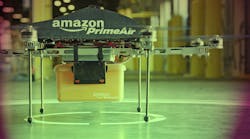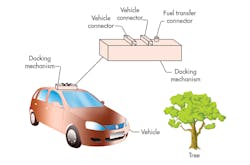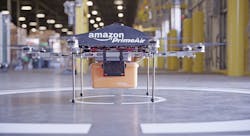Through the use of example systems, devices, and methods, Amazon’s newest patent describes a method to deliver energy using an uncrewed autonomous vehicle (UAV). The patent is intended for vehicles drawing energy from spinning flywheels, combusting hydrocarbons, drawing electric current from capacitors, and so forth. According to the patent, the vehicle could be configured to transport people or items. The system in the patent comprises three parts: a vehicle, a UAV, and a server. But it could include multiple vehicles, UAVs, and servers.
A server may select a UAV and provide instructions to transfer energy to a rechargeable battery at a rendezvous location. (Courtesy of freepatentsonline.com)
The Vehicle
Beyond electric vehicles, the patent notes that the vehicle could include various forms of transportation including cars, trucks, bicycles, etc. The patent also mentions that the vehicle could be controlled by an operator or could operate semiautonomously or fully autonomously. In addition, the vehicle could include an energy source and a power-management module—referred to as the “energy source management module”—to monitor the amount of energy available from the energy source. As a result, it could determine whether there is a need for the vehicle to receive energy. This module also could be configured to monitor the amount of energy that is delivered to the vehicle during energy transfer.
The energy source may comprise one or more devices that provide energy so that vehicle processes may be performed utilizing electric, chemical, or mechanical devices. Those devices store energy for vehicle operation. An example could be rechargeable batteries that supply electric energy. The patent specifically talks about delivering gasoline with a vehicle containing a docking mechanism to transfer fuel from a UAV to a vehicle using fuel transfer connectors. The vehicle in the example could also generate environmental data that indicates, for example, the presence of a tree or another object or hazard. This data could be transferred to the UAV and used when docking with a vehicle.
Here, a docking mechanism is shown attached to the roof of a vehicle. (Courtesy of freepatentsonline.com)
The UAV
The uncrewed autonomous vehicle is described as a mobile machine with no human operator aboard who can operate in one or more autonomous or semiautonomous modes. It could be configured to manage route selections, navigation, piloting, etc. Amazon’s patent mentions how the UAV could have limited altitude (1.86 miles) and range (34.2 miles) compared to human-crewed aircraft. It could also weigh less than 99 lb.
In the patent, it is interesting to see that they are also describing Amazon prime air delivery service when they say, “The UAV could be owned by or associated with merchants, customers, or commercial couriers. For example, a merchant could use the UAV to deliver items that are ordered by the customer.”
An Amazon air delivery drone gets ready for takeoff. (Courtesy of Amazon)
The UAV could use various authentication processes for protection and control to prevent or reduce energy theft. For example, the UAV could be protected from connecting with vehicles controlled by malicious users. Authentication processes also could be used to confirm whether energy was transferred or not. In addition, it will be possible to confirm the amount of energy that was transferred between the UAV and the vehicle. The UAV location data may be stored in a server to help determine which UAV should be instructed to transfer energy to the vehicle.
An additional feature for the UAV could be an energy storage device, which would be configured to store and release energy for transfer to the vehicle. The energy storage device could store energy in one or more forms including, but not limited to: electrical, magnetic, chemical, or mechanical.
The patent mentions that the UAV could include an energy delivery system comprising one or more mechanisms that control the transfer of energy between the UAV and the vehicle. If the energy storage system includes a battery, the energy delivery system could include multiple mechanical arms configured to hold and release a battery. Either the user could insert the battery into the vehicle or the energy delivery system could be configured to provide energy to the vehicle using any of the various wireless energy transmission techniques (e.g., electromagnetic induction or radiation).
Amazon in the Automotive Market
The patent itself does not mean that Amazon has a concrete plan to immediately start a new drone car-charging business. At the moment, the electric/autonomous vehicles market is growing at a fast pace. Better infrastructure will be needed to charge these future vehicles. Amazon had already started a new delivery service using drones to deliver packages to customers in 30 minutes or less; why not use them to delivery energy to vehicles, too?




